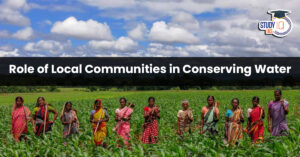Daily Current Affairs for UPSC 2023
Q) Recently seen in news, the Global Slavery Index, 2023 was released by which one of the following organization?
- Walk Free
- Amnesty International
- World Economic Forum
- Institute of Economics and Peace
Daily Current Affairs for UPSC – 12 June April 2023
Explanation:
- Option (1) is correct: The Global Slavery Index 2023 has been released by Walk Free, a human rights organization and is based on data provided by the Global Estimates of Modern Slavery. According to the index, more than 50 million people were living in “modern slavery”. Out of that, 28 million suffer from forced labour and 22 million from forced marriages. About 12 million are children. As per the index the top five countries where prevalence of modern slavery is high are North Korea, Eritrea, Mauritania, Saudi Arabia and Turkey. The practice has become more prevalent over the last five years, as a result of climate change, armed conflict, weak governance and COVID-19. Maximum number of people living in modern slavery can be found in India, China, North Korea, Pakistan and Russia. More than half of all people living in modern slavery are accounted by G20 nations as trade operations and global supply chains allow for human rights abuses.
Q) Consider the following statements about Particularly Vulnerable Tribal Groups (PVTGs):
- Having a stagnant population is one of the criteria for the identification of PVTGs.
- The Ministry of Home Affairs is responsible for the categorization of PVTGs.
- At present, there are 95 PVTGs listed by the government of India.
How many of the statements given above is/are correct?
- Only one
- Only two
- All three
- None
Explanation:
- Statement 1 is correct: Particularly Vulnerable Tribal Groups (PVTGs) are more vulnerable among the tribal groups in India. They have some basic characteristics -they are mostly homogenous, with a small population, relatively physically isolated, social institutes cast in a simple mould, absence of written language, relatively simple technology and a slower rate of change etc. Government of India follows the following criteria for identification of PVTGs:
- Pre-agricultural level of technology.
- Low level of literacy.
- Economic backwardness.
- A declining or stagnant population.
- Statement 2 is correct: In 1973, the Dhebar Commission created Primitive Tribal Groups (PTGs) as a separate category, who are less developed among the tribal groups. In 1975, the Government of India declared 52 such groups, while in 1993 an additional 23 groups were added to the category, making it a total of 75 PVTGs. In 2006, the Government of India renamed the PTGs as Particularly Vulnerable Tribal Groups (PVTGs). The categorization of PVTGs is done by the Ministry of Home Affairs.
- Statement 3 is incorrect: Due to their increased vulnerability, PVTGs require a larger allocation of funds as more developed and assertive tribal groups tend to take a significant portion of these tribal development funds. Among the 75 listed PVTG’s the highest number are found in Odisha.
Q) With reference to ‘Minimum Support Price (MSP)’, consider the following statements:
- It is the price at which the farmer can sell his produce on the open market.
- The MSP is also announced for oilseeds like safflower and nigerseed.
- The current formula for calculating MSP covers all paid-out costs incurred by the farmer in cash as well as kind.
How many of the statements given above is/are correct?
- Only one
- Only two
- All three
- None
Explanation:
- Statement 1 is incorrect but statement 2 is correct: Minimum Support Price (MSP)for a crop is the price at which the government is supposed to procure/buy that crop from farmers if the market price falls below it. During each cropping season, the government announces minimum support prices for 23 crops. Crops covered are:
- 7 types of cereals (paddy, wheat, maize, bajra, jowar, ragi and barley),
- 5 types of pulses (chana, arhar/tur, urad, moong and masur),
- 7 oilseeds (rapeseed-mustard, groundnut, soyabean, sunflower, sesamum, safflower, nigerseed),
- 4 commercial crops (cotton, sugarcane, copra, raw jute)
- Statement 3 is correct: The current formula for calculation of MSP by CACP includes both A2+FL and C2 costs. ‘A2’ covers all paid-out costs incurred by the farmer in cash and kind on seeds, fertilizers, pesticides, hired labour, leased-in land, fuel, irrigation, etc. ‘FL’ includes an imputed value of unpaid family labour.
Q) Consider the following statements about Inflation:
- Recently, the consumer food price index increased above 4 percent.
- Primary articles have the most weight in the wholesale pricing index.
- The headline inflation also considers the increases in the price of food and fuel.
How many of the statements given above is/are correct?
- Only one
- Only two
- All three
- None
Explanation:
- Statement 1 is incorrect: Inflation is the change in the average price of products and services at regular intervals. It represents the purchasing power of a unit of a country’s currency concerning the difference in the price of various products and services. An increase in prices of different commodities and services would mean a decrease in the currency’s purchasing power and vice versa. Consumer food price index (CFPI) eased to 2.91 per cent in May from 3.84 per cent in April 2023. Rural inflation in May stood at 4.17 per cent while urban inflation stood at 4.27 per cent. It is the third successive month that inflation has remained below the Reserve Bank of India’s (RBI’s) upper tolerance limit of 6%.
- Statement 2 is incorrect: Wholesale Pricing Index (WPI) is the price of a typical basket of wholesale items. It considers a basket of 697 items and displays the total costs. Manufactured Products (65% of total weight), Primary Articles (food etc.) (20.1%), and Fuel and Power (5% of total weight) make up the WPI basket (14.9 percent). The Ministry of Commerce and Industry calculates the WPI. WPI measures wholesale prices and was used by the Reserve Bank of India to make monetary policy until 2014.
- Statement 3 is correct: In India, price indices are used to determine changes in commodity and service rates, and so inflation or deflation is computed. The overall inflation rate, commonly known as the headline rate, is calculated by taking into account increases in the price of food, fuel, and other goods.
Q) With reference to ‘Drip irrigation’, consider the following statements:
- It helps reduce the leaching of nutrients below the root zone.
- The ‘Per Drop, More Crop’ micro irrigation scheme focuses on water conservation at the farm level through drip irrigation.
Which of the statements given above is/are correct?
- 1 only
- 2 only
- Both 1 and 2
- Neither 1 nor 2
Explanation:
- Statement 1 is correct: Drip irrigation is a water-saving irrigation practice that involves placing dripwater outlet near the root of the plant, thus improving plant productivity and quality. Drip irrigation technique is 90% efficient at allowing plants to use the water applied. This reduces runoff and evaporation significantly. Since water is applied to root and not between plant rows, there will be significant reduction in weed growth. This improves farm output. Excess water causes nutrients to leech into the ground. Drip irrigation reduces leaching of water and nutrients below the root zone.
- Statement 2 is correct: Per Drop More Crop-Micro Irrigation (PDMC-MI) scheme is a component of Pradhan Mantri Krishi Sinchayee Yojana, focusing on water conservation at the farm level through sprinklers and drip irrigation. The benefit of the scheme is provided to the beneficiary through DBT. Small farmers can get 55% of cost from government and for other farmers it is 45%. Centre and the State share the funding in the ratio 60:40 for all states, except Northeastern and Himalayan states where the ratio is 90:10.


 Draft Digital Personal Data Protection R...
Draft Digital Personal Data Protection R...
 Daily Quiz 28 March 2025
Daily Quiz 28 March 2025
 Role Of Local Communities In Conserving ...
Role Of Local Communities In Conserving ...





















